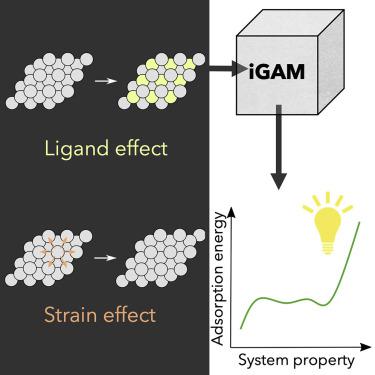Chem ( IF 23.5 ) Pub Date : 2020-09-25 , DOI: 10.1016/j.chempr.2020.09.001 Jacques A. Esterhuizen , Bryan R. Goldsmith , Suljo Linic

|
Developing physically transparent and quantitatively accurate models that relate the chemical interaction (chemisorption strength) between an adsorbate and a solid surface to the adsorption site’s geometry is critical for our understanding of catalysis, corrosion, and electrochemistry. We develop a theory-guided machine-learning (ML) approach, which uses an interpretable class of ML models called generalized additive models (iGAM models), to discover predictive structure-property models that can quantify and explain the link between the geometric structure of an adsorption site and the chemisorption strength. We demonstrate the approach through several case studies, where we analyze the chemisorption strength of chemically distinct adsorbates (O, OH, S, and Cl) on subsurface metal alloy surfaces subjected to various strain- and ligand-induced changes in the local geometric structure. By comparing the ML-derived chemisorption models to previously established electronic-structure models, we clarify the critical physical parameters that control the chemisorption process on metal surfaces.
中文翻译:

理论指导的机器学习发现了地下合金化学吸附的几何结构-性质关系
建立将吸附物和固体表面之间的化学相互作用(化学吸附强度)与吸附部位的几何形状相关的物理透明且定量准确的模型,对于我们对催化,腐蚀和电化学的理解至关重要。我们开发了一种理论指导的机器学习(ML)方法,该方法使用称为通用加性模型(iGAM模型)的一类可解释的ML模型,以发现可量化和解释模型几何结构之间联系的预测结构-属性模型。吸附部位和化学吸附强度。我们通过几个案例研究证明了该方法,其中我们分析了化学上不同的被吸附物(O,OH,S,和Cl)在地下金属合金表面上经受各种应变和配体诱导的局部几何结构变化。通过将ML衍生的化学吸附模型与先前建立的电子结构模型进行比较,我们阐明了控制金属表面化学吸附过程的关键物理参数。



























 京公网安备 11010802027423号
京公网安备 11010802027423号